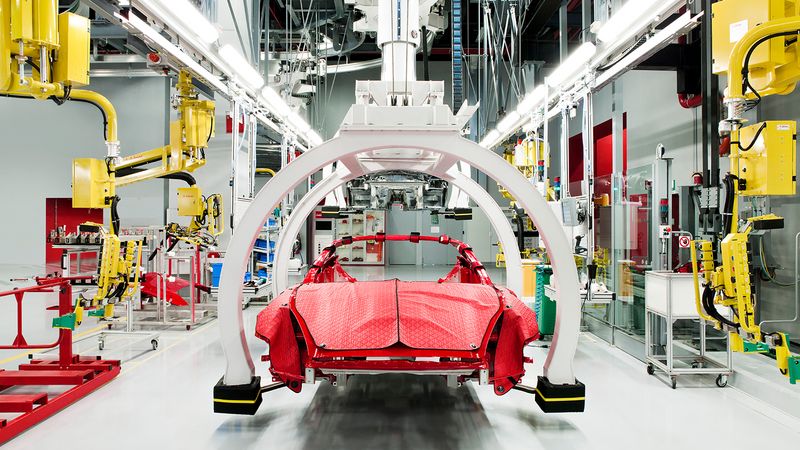THE JOURNAL

The manufacturing of the Ferrari California Car. Photograph by Ferrari, courtesy of Phaidon
Nine Facts About Ferrari Only Purists Will Know.
Depending on your interest in cars, we imagine you already know a fair bit about Ferraris. You probably know that the company built the most expensive car ever sold at auction – a 1962 250 GTO that went for $38 million in a sale in Carmel, California in 2014 – and that Ferraris account for 15 of the 20 most expensive cars ever sold at auction. You might know that Ferrari has won more Formula 1 grand prix (229) than any other team. You ought to know that the company is Italian and made motoring icons like the F40, the Testarossa, and the Enzo. Being a MR PORTER guy, you might even know that the Daytona driven by the character James “Sonny” Crockett in the Miami Vice television show, and the 250 GT in the film Ferris Bueller’s Day Off, were fakes.
However, perusing Ferrari: Under The Skin, a new Phaidon book that ties in with an exhibition at London’s Design Museum, we discovered many interesting things we didn’t previously know about the company. Here are nine of them.
01. As a driver, Mr Enzo Ferrari was second only to the very best
In his final competitive drive, a hill climb near Piacenza in 1931, Mr Enzo Ferrari came second, beaten only by Mr Tazio Nuvolari, a man described described as “the greatest driver of the past, the present, and the future” by Mr Ferdinand Porsche, founder of the German sports car manufacturer.
02. Ferrari’s design ethos is all about excess
When working on 2003’s Formula 1-inspired Enzo supercar, the then Ferrari boss Mr Luca Cordero di Montezemolo asked Pininfarina, the studio working on the design to, “Be extreme and go too far. We can always come back.”
03. Mr John Lennon’s first car was a Ferrari
In February 1965, Mr John Lennon passed his driving test. From the luxury cars presented to him by hopeful dealers Mr Lennon selected a Ferrari 330GT 2+2.
04. They could have built Ferraris in Detroit
In 1963, Mr Enzo Ferrari was talking to Ford about selling the American firm 90 per cent of his road car business. At the last minute, the deal fell through because Ford wished to take control of the budget for the Ferrari racing team, something Mr Ferrari couldn’t countenance.
05. Mr Enzo Ferrari was nearly eaten by wolves
Signor Ferrari’s second competitive race was the 1919 Targa Florio, an endurance event in Sicily. That November, he had to drive his CMN race car from Milan, where he lived, all the way down to the race. The journey was made in blizzard conditions and at one stage Mr Ferrari and his team mates were threatened by hungry wolves.
06. The first Ferrari road car was shown in 1949
The 166 Inter was a grand tourer unveiled at the Paris Motor Show. Ferrari’s Mr Gioacchino Colombo designed a two-litre, V12 engine, which produced between 110 and 140 HP, while a separate company of coachbuilders, Carrozzeria Touring designed and built the beautiful body. Mr Ferrari insisted the engine be a V12 for its elegance and sound, and that the car have five gears (four was standard at the time).
07. The prancing horse logo was inspired by an Italian pilot
In 1923, Mr Ferrari won a race in Ravenna, where he met Count and Countess Baracca. Their son, Francesco, was a pilot who had died in WWI. As a tribute, the Countess suggested that Mr Ferrari use the prancing horse that had adorned her son’s aeroplanes as a symbol on his cars.
08. Ferrari’s image was created by another company
Pininfarina, an Italian design studio and coachbuilder, created the look of every Ferrari road car between 1951 and 2011 with one exception – the 1973 Bertone-penned Dino 308 GT4. Since 2011, Ferraris have been designed in-house at Centro Stile Ferrari under the aegis of Mr Flavio Manzoni.
09. The company pioneered paddle-shift gearboxes
Mr John Barnard joined Ferrari in 1987 to design its race cars, and introduced paddle-shift gearboxes. Ferrari’s victory in the 1989 Rio de Janeiro was the first grand prix won by a car with a paddle-shift gearbox, and the 1997 F355 road car was the first production car to use one.
